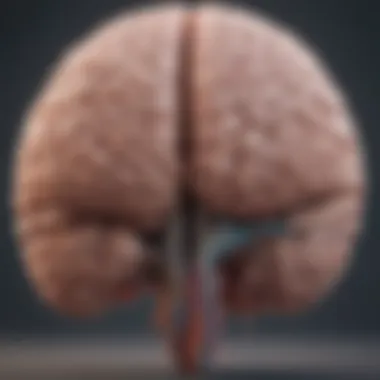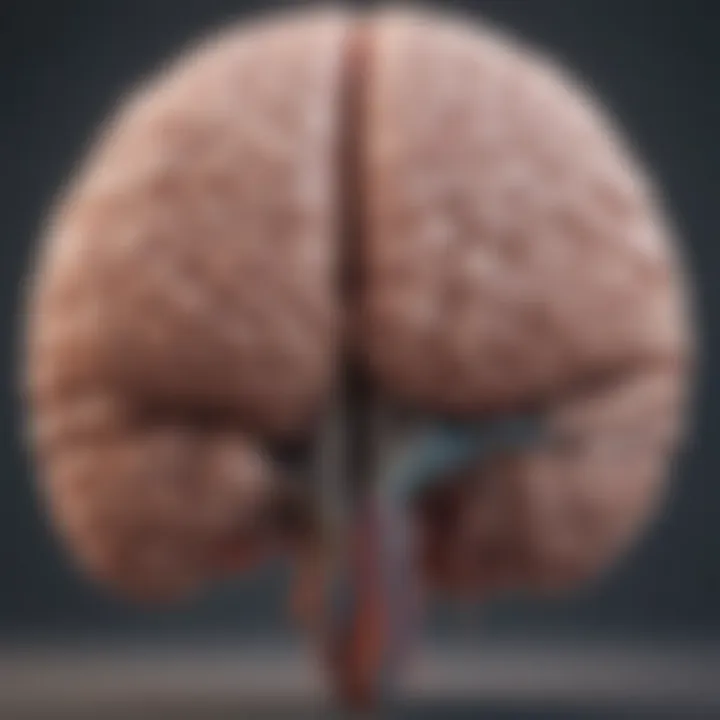Understanding the Causes of Lewy Body Dementia


Research Context
Background and Rationale
Lewy Body Dementia (LBD) sits at the intersection of Alzheimer's disease and Parkinson's disease. It encompasses a range of symptoms, such as cognitive decline, visual hallucinations, and movement difficulties. Understanding LBD is critical for both diagnostic accuracy and treatment options. The roots of this condition are not yet fully understood, making research into its causes essential.
Recent studies suggest that a convergence of genetic and environmental factors contributes to the onset of LBD. By exploring these elements, we lay the groundwork for better therapeutic strategies that can enhance patient outcomes. The multidimensional nature of LBD calls for an integrated research approach, and this article aims to shed light on the diverse pathways leading to its development.
Literature Review
Existing literature has identified several mechanisms associated with LBD. Research conducted by the Alzheimer’s Association reveals a correlation between certain genetic mutations and an increased risk of developing Lewy Body Dementia.
Additionally, environmental influences, such as exposure to toxins, have also been studied. A review of various studies indicates that neurotoxins like those found in certain pesticides can have an impact on brain health, potentially leading to Lewy body formation.
Moreover, some studies point to the involvement of gut microbiota in neurological disorders, including LBD. This emerging field suggests that gut health may influence brain health, a link that warrants further investigation.
Key Research Findings
- Genetic Factors:
- Environmental Influences:
- Neuroanatomical Considerations:
- Mutations in the SNCA gene have been implicated in familial LBD cases.
- Variations in genes such as GBA and MAPT are also associated with an increased risk.
- Studies consistently show that certain chemical exposures heighten the risk of neurodegenerative diseases.
- Lifestyle factors, including diet and physical activity, may play a role in disease progression.
- Abnormal protein deposits, primarily alpha-synuclein, are the hallmark of LBD. Understanding their formation is vital.
Understanding these factors is not merely academic; it has practical implications for treatment and prevention. By synthesizing this knowledge, the medical community can better understand Lewy Body Dementia and improve the tools available for diagnosis and management.
Next Steps
The following sections will delve deeper into the specific genetic and environmental elements contributing to Lewy Body Dementia as well as the methods currently being utilized in the research. These insights will serve both as foundational knowledge and a springboard for further inquiry into ongoing investigations.
Intro to Lewy Body Dementia
Lewy Body Dementia (LBD) is a complex condition that intertwines various biological, genetic, and environmental factors. Understanding this topic is crucial for several reasons. First, LBD is often misdiagnosed, causing delays in treatment and management. Gaining insight into its symptoms and causes can lead to better identification. Second, LBD is the second most common type of degenerative dementia after Alzheimer’s disease. By comprehending its underlying mechanisms, researchers and healthcare professionals can develop targeted therapeutic strategies that improve the quality of life for affected individuals.
The necessity to explore Lewy Body Dementia lies also in its incremental growth in prevalence as populations age. As more individuals confront this condition, awareness and education are vital. Studying its causes allows us to recognize patterns that may help in prevention. Moreover, it is increasingly being linked to other neurodegenerative disorders, indicating that understanding LBD can contribute to a broader comprehension of brain health in general.
Overview of Lewy Body Dementia
Lewy Body Dementia is characterized by the presence of abnormal protein deposits called Lewy bodies in the brain. These deposits disrupt normal brain function and are associated with the loss of neurons that produce dopamine, a critical neurotransmitter. Symptoms of LBD can include visual hallucinations, fluctuations in cognitive ability, and motor symptoms similar to Parkinson's disease.
The impact of these symptoms on daily living can be profound, often affecting an individual’s ability to perform routine tasks and maintain social relationships. As the disease progresses, individuals may experience increasing cognitive decline and may require comprehensive care and support.
Importance of Understanding Causes
Second, comprehending the causative factors may enhance early diagnosis. Recognizing patterns and connections in familial cases can lead to improved screening protocols for high-risk individuals. Furthermore, knowledge about the causes improves treatment options. If researchers understand what triggers neurodegeneration in Lewy Body Dementia, they can target specific pathways with innovative therapies.
Definition of Lewy Bodies
Understanding Lewy Bodies is essential in the study of Lewy Body Dementia (LBD). Lewy Bodies are abnormal aggregates of protein that can disrupt the normal functioning of brain cells. Recognizing their role provides insight into the pathophysiology of LBD and aids in the early diagnosis of this condition. The study of Lewy Bodies encompasses several critical elements, including their characteristics, formation mechanisms, and implications for neurodegeneration. This knowledge not only enhances our understanding of LBD but also lays the groundwork for future investigative and therapeutic endeavors.
Characteristics of Lewy Bodies
Lewy Bodies are primarily composed of alpha-synuclein protein. Their size typically ranges from several microns to a few micrometers. In histological examinations, Lewy Bodies appear as spherical shapes with a dense core surrounded by a halo of cytoplasmic material. These structures are found in the cortex, brainstem, and substantia nigra, affecting various brain regions that influence cognitive and motor functions. The presence of these bodies can lead to the impairment of neurotransmitter production and neuronal communication.
A few characteristics worth noting include:
- Shape and Structure: Lewy Bodies have a distinct morphology that differentiates them from other neurodegenerative aggregations.
- Cellular Impact: They interfere with the normal processes within neurons, contributing to cell death.
- Associations with Other Conditions: Lewy Bodies can co-occur with other dementia types, like Alzheimer's, complicating the clinical picture.
Role in Neurodegeneration
The role of Lewy Bodies in neurodegeneration is significant, as they are strongly tied to the mechanisms leading to cell dysfunction and death. While the precise pathways remain a subject of active research, several processes have been identified:
- Impacts on Neurotransmitters: They disrupt the balance of neurotransmitters, particularly dopamine, leading to motor and cognitive decline.
- Cellular Stress Responses: Lewy Bodies trigger stress responses in neurons, leading to inflammation and further degeneration.
- Pathology Progression: As Lewy Bodies accumulate, they exacerbate the condition of the surrounding neural tissue, resulting in widespread neurodegeneration.
Understanding the effects and characteristics of Lewy Bodies provides a framework for exploring therapeutic strategies and potential interventions in Lewy Body Dementia. The intricate relationship between these protein aggregates and neurodegeneration highlights the need for continued research and innovation in treatment approaches.


Genetic Factors in Lewy Body Dementia
Genetic factors play a crucial role in understanding Lewy Body Dementia (LBD). Identifying the genetic components involved helps in discerning why certain individuals develop this condition while others do not. The exploration of genetic influences provides insight into both familial clustering of LBD and the variations observed in disease manifestation among individuals. This section delves into familial patterns, specific genetic mutations linked to LBD, and the broader concept of genetic predisposition and risk factors.
Familial Patterns of Inheritance
Familial patterns of inheritance signify a potential genetic basis for LBD. In some families, multiple members exhibit symptoms of LBD, suggesting that genes may influence the disorder's onset. Studies observe that having a first-degree relative with LBD increases the risk, indicating a hereditary component. However, it is vital to note that not all familial cases are straightforward. Environmental and lifestyle factors may interact with genetic predispositions, complicating the inheritance patterns. This underscores the need to appreciate the complexity of genetic contributions to LBD risk.
Identified Genetic Mutations
Identifying specific genetic mutations forms a central aspect of understanding Lewy Body Dementia. Research has focused on several key genes, particularly those associated with the production and regulation of proteins linked to neurons and brain health.
SNCA gene mutations
SNCA gene mutations are often linked with the development of LBD. The SNCA gene encodes alpha-synuclein, a protein that aggregates in Lewy bodies, the hallmark of this dementia type. Abnormalities in this gene can significantly contribute to the neurodegeneration observed in LBD. Testing for SNCA mutations allows researchers to understand better how these genetic anomalies lead to protein misfolding, which is critical for LBD pathology. This unique aspect makes it a popular focal point for many discussions surrounding dementia.
LRRK2 gene mutations
LRRK2 gene mutations have gained attention as well, particularly in the context of Parkinson's disease and its relationship with LBD. The LRRK2 gene is involved in cellular signaling pathways crucial for neuronal health. Mutations can disrupt normal function, leading to increased susceptibility to neurodegeneration. This emphasis on LRRK2 provides a beneficial lens through which researchers can understand overlapping mechanisms between Parkinson's disease and LBD. Its exploration reveals essential insights into shared pathways in these related disorders.
PRPN gene implications
PRPN gene implications are another significant area of investigation. The prion protein encoded by this gene plays a role in neuroprotection and cellular resilience. Variations within the PRPN gene can lead to dysfunctional protein expression, which may contribute to the development of neurodegenerative diseases, including LBD. Focusing on PRPN enriches the current understanding of genetic factors in LBD specifically, highlighting its impact on neural health and vulnerability to degeneration.
Genetic Predisposition and Risk Factors
Genetic predisposition encapsulates the risk factors associated with developing LBD. Multiple studies indicate that specific genetic profiles can increase the likelihood of LBD. The presence of certain genetic mutations does not guarantee the development of the disease, but it can heighten susceptibility. Furthermore, external factors such as environmental influences often interact with these genetic elements. Understanding genetic predisposition assists researchers and clinicians in identifying high-risk individuals who may benefit from early intervention and monitoring. By clarifying these relationships, we can gain a more profound appreciation of the multifaceted nature of Lewy Body Dementia.
Environmental Contributors
Understanding environmental contributors to Lewy Body Dementia (LBD) is essential to painting a broader picture of the disease's etiology. While genetic factors offer insights into inherited risks, it is the interplay between an individual’s genetic makeup and their environment that often determines disease susceptibility. This section analyzes specific elements like exposure to toxins and the impact of head injuries, highlighting their significance in the development of LBD.
Exposure to Toxins
Environmental toxins can play a pivotal role in neurodegenerative diseases, including Lewy Body Dementia. Various studies have indicated that prolonged exposure to certain chemicals, such as pesticides and heavy metals, may increase the risk of developing neurodegenerative disorders.
Some key toxins to consider include:
- Agricultural pesticides: Long-term exposure to these chemicals has been linked with increased rates of Parkinson’s disease, which shares overlapping symptoms and pathology with LBD.
- Solvents: Chemical exposure from products used at home or in industrial settings can contribute to neurological damage.
- Heavy metals: Elements like lead and mercury have toxic effects on neuronal integrity and function.
The mechanisms through which these toxins affect the brain are complex. They may induce oxidative stress, disrupt cellular processes, or provoke inflammatory responses in neural tissue. Understanding how these environmental factors contribute to LBD could lead to better preventive strategies.
Role of Head Injuries
Head injuries are recognized risk factors for various forms of dementia, including LBD. Traumatic brain injuries (TBI) can result in immediate and lingering neurological consequences, influencing the development of neurodegenerative conditions later in life.
Several points underline the importance of recognizing head injuries as a contributing factor:
- Increased risk: Evidence suggests that individuals with a history of significant head trauma are at a heightened risk for cognitive decline and disorders like LBD.
- Neuroinflammation: TBIs can induce chronic inflammation in the brain, which may lead to the formation of Lewy bodies. This connection underscores the importance of managing and preventing head injuries.
- Repetitive injuries: Athletes in contact sports are particularly susceptible to multiple minor head injuries, potentially compounding the risk of developing LBD.
"When considering the complexity of Lewy Body Dementia, both genetics and environmental factors must be examined to develop comprehensive treatment and prevention strategies."
In summary, the connection between environmental contributors and Lewy Body Dementia cannot be overlooked. Factors such as exposure to toxins and incidences of head injuries are critical in understanding the disease's development and progression. As research continues to explore these areas, findings may offer new insights into preventative measures and treatment options.
Neuroanatomical Changes in LBD
Understanding neuroanatomical changes in Lewy Body Dementia (LBD) is essential. This knowledge encompasses the physical alterations in the brain caused by Lewy bodies. These changes have far-reaching implications for how the disease progresses and affects patients. Recognizing the specific regions impacted can guide both diagnosis and potential treatment strategies.
Regions Affected by Lewy Bodies
Lewy bodies, which are abnormal aggregates of proteins, primarily affect certain regions in the brain. The most significantly impacted areas include the:
- Cortex: Involved in cognitive functions, the cortex shows thinning due to LBD.
- Basal Ganglia: Responsible for movement control, changes here lead to motor symptoms common in LBD.
- Substantia Nigra: This area is crucial for the regulation of mood and movement. It is often one of the first affected regions in LBD, contributing to Parkinsonian symptoms.
These regions are interrelated in their functions. The alterations in their anatomy result not only in cognitive deficits but also in behavioral and emotional disturbances. As these changes occur, patients may experience confusion, hallucinations, and varying degrees of motor dysfunction.
Impact on Neural Pathways


The neuroanatomical changes in LBD affect neural pathways extensively. This disruption is critical in understanding the overall pathophysiology of the disease. Some important aspects include:
- Disruption of Communication: The connections between the affected regions become impaired, leading to confusion in signal transmission.
- Degenerative Processes: As the Lewy bodies affect these pathways, normal neurochemical activities are impaired, resulting in diminished cognitive and motor functions.
- Compensatory Mechanisms: In response to these changes, the brain might attempt to form new connections, although this is often insufficient to counteract the degeneration.
Understanding these neural pathway disruptions is vital for developing effective interventions. The focus on how the brain adapts, or fails to adapt, may provide insights into new avenues for treatment.
Pathophysiology of Lewy Body Dementia
Understanding the pathophysiology of Lewy Body Dementia (LBD) is crucial for grasping how the disease develops and affects individuals. This area encompasses the mechanisms that lead to neurodegeneration and the inflammatory responses involved in the disease. Recognizing these elements enhances our knowledge of how Lewy bodies disrupt normal brain function, which can inform treatment strategies and improve patient outcomes. Through examining both the mechanisms of neurodegeneration and the inflammatory responses, we can appreciate the complexity and multifaceted nature of LBD.
Mechanisms of Neurodegeneration
The neurodegenerative mechanisms in Lewy Body Dementia involve the accumulation of abnormally folded proteins, mainly alpha-synuclein. This protein aggregates into structures known as Lewy bodies, which disrupt neuronal function and viability. These aggregated proteins can initiate a cascade of cellular events that ultimately lead to neuron death, significantly impacting regions of the brain involved in cognition, movement, and behavior.
In addition, the loss of dopaminergic neurons, particularly in the substantia nigra, plays a key role in the motor symptoms observed in LBD. This degeneration creates a lack of dopamine, a neurotransmitter critical for coordinating movement. As neurons in this area die, patients may experience tremors, rigidity, and slowed movement.
Other contributing factors include:
- Oxidative Stress: Increased levels of free radicals can damage neuronal components, leading to cell death and exacerbating cognitive decline.
- Mitochondrial Dysfunction: Impaired energy production affects neuronal survival and function, as neurons have high energy demands.
- Calcium Dysregulation: Abnormal calcium levels can trigger apoptosis, or programmed cell death, in neurons affected by LBD.
Understanding these mechanisms provides vital insights into potential therapeutic targets. By identifying ways to mitigate these pathways, researchers can work toward halting or reversing neurodegeneration associated with LBD.
Inflammatory Responses in LBD
Inflammation plays a significant role in the progression of Lewy Body Dementia. The brain’s immune system, primarily mediated by microglia, becomes activated in response to the presence of Lewy bodies and other cellular stressors. This immune response can have both protective and detrimental effects. While initially, it may seek to remove damaged cells and debris, chronic inflammation can exacerbate neuronal damage over time.
Key aspects of inflammatory responses in LBD include:
- Microglial Activation: Infiltration of immune cells into the brain can lead to the sustained release of pro-inflammatory cytokines, which may contribute to neuroinflammation and neuronal loss.
- Blood-Brain Barrier Disruption: Inflammatory cytokines can compromise the protection offered by the blood-brain barrier, making it easier for harmful substances to enter the brain and contribute to further damage.
- Neuronal Dysfunction: Sustained inflammation influences neurotransmitter systems, which may worsen cognitive and behavioral symptoms associated with LBD.
According to recent studies, targeting inflammatory pathways may offer therapeutic opportunities. For instance, anti-inflammatory drugs could potentially mitigate some of the adverse effects of inflammation in LBD.
"In chronic neurodegenerative diseases like LBD, the fine balance between protective and pathological inflammation is crucial for understanding disease progression."
Cognitive and Behavioral Manifestations
Understanding cognitive and behavioral manifestations in Lewy Body Dementia (LBD) is pivotal for comprehending the broader implications of this condition. These manifestations significantly affect patients' quality of life and influence the caregiving approaches. Therefore, recognizing their early symptoms can enhance diagnosis and tailored interventions. Cognitive impairments and behavioral disturbances represent the dual aspects that clinicians and researchers must address to develop effective treatment strategies.
Cognitive Impairments
Cognitive impairments in LBD often manifest as executive dysfunction, memory issues, and attention deficits. Patients may exhibit problems in planning, organizing, and problem-solving tasks. These difficulties do not only hinder daily activities but can also lead to frustration and confusion in both patients and caregivers.
- Memory Loss: Memory loss, particularly in the early stages, may not follow typical Alzheimer’s patterns. Instead, it often presents more as fluctuating episodes of confusion or forgetfulness.
- Attention Deficits: Sustaining attention, especially in distracting environments, becomes challenging. This factor can further complicate the management of everyday life.
Research suggests that these cognitive symptoms stem from the disruption in neural networks due to Lewy body accumulation. This highlights the need for targeted cognitive rehabilitation strategies that can support functioning and improve memory retention.
Behavioral Disturbances
Behavioral disturbances are common and can range from mood swings to hallucinations. These symptoms often fluctuate, adding another layer of complexity to the overall patient picture. Understanding these changes is essential for appropriate management and care.
- Hallucinations: Patients might experience visual or auditory hallucinations. Such experiences are often distressing, creating additional challenges for communication.
- Mood Changes: Individuals may show signs of anxiety, depression, or apathy. These changes can significantly impact their interactions and emotional well-being.
- Sleep Disorders: Sleep disturbances are frequent in LBD. Patients often face issues such as REM sleep behavior disorder, leading to physical movements during sleep.
Patients' behavioral manifestations often lead to misunderstandings within family and social circles. Providing education to caregivers about these symptoms can foster better support systems. Approaches that focus on behavioral interventions alongside medical treatments can mitigate some of these disturbances.
Understanding the cognitive and behavioral aspects of Lewy Body Dementia is crucial for implementing effective management strategies and improving patients' overall quality of life.
Diagnostic Considerations
Understanding the diagnostic considerations for Lewy Body Dementia (LBD) is crucial in distinguishing it from other dementias. This section discusses the significance of accurate diagnosis and the elements that administrative and healthcare professionals must consider. Misdiagnosis can lead to inappropriate treatment plans, affecting patient care and overall quality of life. Thus, clarity in diagnostic criteria can play a major role in medical practice.
Diagnostic Criteria for LBD
The diagnostic criteria for Lewy Body Dementia are established through several frameworks, primarily by the Dementia with Lewy Bodies Consortium. These criteria help to outline the necessary clinical features that must be present for an accurate diagnosis. Key features include:
- Core clinical features: Fluctuations in cognition, recurrent visual hallucinations, and parkinsonism.
- Supported criteria: These include conditions like REM sleep behavior disorder or severe neuroleptic sensitivity.
- Exclusion of other causes: Other medical conditions must be ruled out, ensuring that symptoms are not attributable to an alternative diagnosis.
To summarize the diagnosis of LBD, it is important to gather a thorough medical history and conduct comprehensive cognitive assessments. Such steps ensure that the characteristic symptoms, which define LBD, are properly recognized and documented.


Differential Diagnosis
Differential diagnosis is essential in distinguishing Lewy Body Dementia from other neurodegenerative disorders like Alzheimer's disease or Parkinson's disease dementia. Key considerations in this process include:
- Overlap of symptoms: Many dementias share similar cognitive and behavioral symptoms, most notably memory loss, confusion, and visual hallucinations.
- Variability of symptoms: LBD can present with fluctuating cognitive abilities, which is often less pronounced in other types of dementia.
- Neurological examinations: Specialized tests and imaging studies (e.g., MRI or CT scans) assist in identifying specific patterns associated with LBD versus other dementias.
- Clinical assessment tools: Various tools can be used, like the Clinical Dementia Rating (CDR) scale, to gauge cognitive decline more accurately.
Accurate differential diagnosis is not just a matter of confirming or denying LBD; it determines the treatment avenues and support systems that are put in place for patients.
Current Research Directions
Research on Lewy Body Dementia (LBD) emphasizes the need to unravel its complex etiology. These emerging findings will likely reshape our understanding and approach to this disorder. By focusing on both genetic and environmental aspects, researchers seek to explain how various factors interplay in contributing to LBD. This section delves into significant areas of ongoing assessments that may enhance diagnostic and therapeutic strategies in the near future.
Investigating Genetic Links
Genetic research remains paramount in comprehending LBD. Defining genetic contributions helps clarify which individuals may be at higher risk. Several genes have been studied, notably the SNCA gene, LRRK2 gene, and PRPN gene. Each of these genes plays a role in the protein processing and neuronal health, which are crucial in understanding LBD. For example, mutations in the SNCA gene have been associated with familial cases of Parkinson's disease, where Lewy bodies are also found.
The investigation into genetic predisposition for LBD may lead to several benefits:
- Early Detection: Recognizing genetic markers that indicate risk can help in the early identification of LBD.
- Personalized Treatment: Understanding genetic influences on disease progression can result in tailored medical treatment strategies.
- Family Counseling: Identifying familial patterns allows for better counseling for at-risk family members.
Currently, research is also focusing on other less characterized organic mutations, which may lend new insights into the genetic landscape of LBD.
Exploring Environmental Interactions
Environmental factors equally contribute to the development of LBD. Research suggests that exposure to toxins, stressful life events, and prior head injuries may elevate the risk of developing this form of dementia. Toxins, for instance, can include pesticides and industrial chemicals. Studies have found that prolonged exposure to such substances may accelerate neurodegeneration.
Concerning head injuries, particular emphasis is on the long-term consequences of even mild traumatic brain injuries. These injuries may cause cumulative damage over time and increase the likelihood of cognitive decline.
Consider the following points related to environmental interactions:
- Lifestyle Factors: Poor diet, lack of exercise, and social isolation can influence overall brain health and introduce risks of LBD.
- Longitudinal Data: Large cohort studies assessing environmental factors across years are necessary for accurate data.
- Interdisciplinary Approach: Collaboration among neuroscientists, epidemiologists, and environmental health specialists can provide a holistic understanding of LBD.
By recognizing and delving into both genetic and environmental factors, research may pave the way for uncovering prevention methods and innovative treatment avenues, ultimately leading to better outcomes for individuals with LBD.
Future Perspectives in LBD Research
Research in Lewy Body Dementia (LBD) is a rapidly evolving field. Understanding the future directions of this research provides valuable insights into potential breakthroughs in treatments and patient care. The complexity of LBD necessitates a multifaceted approach, focusing on both therapeutic targets and innovative research methodologies. Increased funding and interest in LBD research could lead to significant advancements in how we diagnose and manage the disease.
Potential Therapeutic Targets
Identifying potential therapeutic targets is critical for advancing treatment options for Lewy Body Dementia. Here are some areas of focus:
- Alpha-synuclein Pathology: The aggregation of alpha-synuclein in the brain is a hallmark of LBD. Researchers are investigating drugs that can inhibit the formation of these aggregates. This could slow the progression of the disease and mitigate symptoms.
- Cholinergic System: Many studies emphasize the role of cholinergic dysfunction in LBD. Targeting cholinergic receptors could enhance cognitive function and alleviate some behavioral symptoms.
- Inflammation: Neuroinflammation plays a significant role in neurodegenerative diseases, including LBD. Therapies aimed at reducing inflammation may prove beneficial. Agents that modulate the immune response in the brain are currently under evaluation.
Additionally, understanding the genetic underpinnings, more precise drug development tailored to individual genetic profiles could emerge as a novel therapeutic approach.
Longitudinal Studies and Their Importance
Longitudinal studies are vital in LBD research. They allow researchers to track disease progression over time in a real-world context. This long-term observation is essential for several reasons:
- Understanding Progression: Tracking how symptoms evolve in patients provides crucial data on the natural history of LBD.
- Evaluating Treatments: Longitudinal studies can assess the effectiveness of new therapies over extended periods, helping researchers determine which approaches yield meaningful benefits.
- Identifying Biomarkers: Researchers aim to find reliable biomarkers that signify disease progression or response to treatment. Long-term studies make it easier to identify these indicators, contributing to better diagnostic capabilities.
"The complexity of Lewy Body Dementia necessitates new strategies that bridge genomics, neuroscience, and clinical practice."
Engagement from multiple disciplines and advancements in technology will be key drivers in pushing this research forward.
End
The discussion on the causes of Lewy Body Dementia (LBD) is fundamental for a comprehensive understanding of the disease itself. In this article, we have dissected the various components that contribute to LBD, emphasizing the interplay between genetic and environmental factors. This exploration is essential for symptoms identification, understanding disease progression, and developing strategies to aid affected individuals.
Summary of Key Findings
In summary, several key findings arose throughout the article:
- Genetic Factors: Mutations in genes such as SNCA, LRRK2, and PRPN show significant links to LBD. Familial patterns of inheritance were also noted, indicating a heritable component that merits further investigation.
- Environmental Influences: Toxin exposure and head injuries are highlighted as critical risk factors. Understanding these environmental contributors helps reveal modifiable risks, prompting preventive measures.
- Neuroanatomical Changes: The regions of the brain affected by Lewy bodies significantly alter neural functions, resulting in cognitive and behavioral symptoms that characterize LBD.
- Research Directions: Current research is focused on elucidating genetic links and environmental interactions, with ongoing studies proposing potential pathways for new therapies.
Implications for Future Research
The implications for future research into LBD are substantial. The multifactorial nature of the disease suggests that understanding its etiology could lead to more effective treatment options. Here are some key aspects:
- Genetic Research: Further studies on genetic predispositions can aid in developing screening tools that identify at-risk individuals early. Identifying specific mutations could offer insights for tailored interventions.
- Environmental Studies: Research into environmental toxins should be expanded to better understand their specific roles in LBD. Investigating protective factors might also be beneficial.
- Long-Term Data Collection: Longitudinal studies can provide valuable information about disease progression and variations in symptoms over time. This information could greatly enhance therapeutic strategies and patient care.
Overall, the insights gained from this structured exploration highlight the need for a continued focus on both genetic and environmental contributors to Lewy Body Dementia. Understanding these aspects is not only crucial in framing effective treatment protocols but also in raising public awareness about dementia-related disorders.



